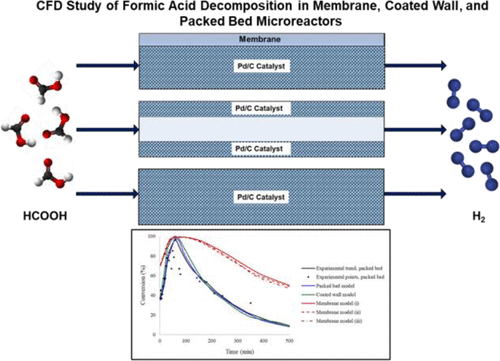当前位置:
X-MOL 学术
›
Ind. Eng. Chem. Res.
›
论文详情
Our official English website, www.x-mol.net, welcomes your
feedback! (Note: you will need to create a separate account there.)
Computational Investigation of Microreactor Configurations for Hydrogen Production from Formic Acid Decomposition Using a Pd/C Catalyst
Industrial & Engineering Chemistry Research ( IF 3.8 ) Pub Date : 2022-01-20 , DOI: 10.1021/acs.iecr.1c04128 Sanaa Hafeez 1 , Sultan M. Al-Salem 2 , Atul Bansode 3 , Alberto Villa 4 , Nikolaos Dimitratos 5 , George Manos 1 , Achilleas Constantinou 6
Industrial & Engineering Chemistry Research ( IF 3.8 ) Pub Date : 2022-01-20 , DOI: 10.1021/acs.iecr.1c04128 Sanaa Hafeez 1 , Sultan M. Al-Salem 2 , Atul Bansode 3 , Alberto Villa 4 , Nikolaos Dimitratos 5 , George Manos 1 , Achilleas Constantinou 6
Affiliation

|
The need to replace fossil fuels with sustainable alternatives has been a critical issue in recent years. Hydrogen fuel is a promising alternative to fossil fuels because of its wide availability and high energy density. For the very first time, novel microreactor configurations for the formic acid decomposition have been studied using computational modeling methodologies. The decomposition of formic acid using a commercial 5 wt % Pd/C catalyst, under mild conditions, has been assessed in packed bed, coated wall, and membrane microreactors. Computational fluid dynamics (CFD) was utilized to develop the comprehensive heterogeneous microreactor models. The CFD modeling study begins with the development of a packed bed microreactor to validate the experimental work, subsequently followed by the theoretical development of novel microreactor configurations to perform further studies. Previous work using CFD modeling had predicted that the deactivation of the Pd/C catalyst was due to the production of the poisoning species CO during the reaction. The novel membrane microreactor facilitates the continuous removal of CO during the reaction, therefore prolonging the lifetime of the catalyst and enhancing the formic acid conversion by approximately 40% when compared to the other microreactor configurations. For all microreactors studied, the formic acid conversion increases as the temperature increases, and the liquid flow rate decreases. Further studies revealed that all microreactor configurations had negligible internal and external pore diffusion resistances. The detailed models developed in this work have provided an interesting insight into the intensification of the formic acid decomposition reaction over a Pd/C catalyst.
中文翻译:

使用 Pd/C 催化剂从甲酸分解制氢的微反应器配置的计算研究
近年来,用可持续替代品替代化石燃料的需求一直是一个关键问题。氢燃料因其广泛的可用性和高能量密度而成为化石燃料的有前途的替代品。首次使用计算建模方法研究了用于甲酸分解的新型微反应器配置。已经在填充床、涂层壁和膜微反应器中评估了在温和条件下使用商业 5 wt% Pd/C 催化剂分解甲酸的情况。计算流体动力学 (CFD) 用于开发全面的异质微反应器模型。CFD 建模研究从开发填充床微反应器开始,以验证实验工作,随后是新型微反应器配置的理论发展,以进行进一步的研究。先前使用 CFD 建模的工作预测 Pd/C 催化剂的失活是由于反应过程中产生了有毒物质 CO。新型膜微反应器有助于在反应过程中连续去除 CO,因此与其他微反应器配置相比,延长了催化剂的寿命并将甲酸转化率提高了约 40%。对于所研究的所有微反应器,甲酸转化率随着温度升高而增加,并且液体流速降低。进一步的研究表明,所有微反应器配置的内部和外部孔扩散阻力都可以忽略不计。
更新日期:2022-02-02
中文翻译:

使用 Pd/C 催化剂从甲酸分解制氢的微反应器配置的计算研究
近年来,用可持续替代品替代化石燃料的需求一直是一个关键问题。氢燃料因其广泛的可用性和高能量密度而成为化石燃料的有前途的替代品。首次使用计算建模方法研究了用于甲酸分解的新型微反应器配置。已经在填充床、涂层壁和膜微反应器中评估了在温和条件下使用商业 5 wt% Pd/C 催化剂分解甲酸的情况。计算流体动力学 (CFD) 用于开发全面的异质微反应器模型。CFD 建模研究从开发填充床微反应器开始,以验证实验工作,随后是新型微反应器配置的理论发展,以进行进一步的研究。先前使用 CFD 建模的工作预测 Pd/C 催化剂的失活是由于反应过程中产生了有毒物质 CO。新型膜微反应器有助于在反应过程中连续去除 CO,因此与其他微反应器配置相比,延长了催化剂的寿命并将甲酸转化率提高了约 40%。对于所研究的所有微反应器,甲酸转化率随着温度升高而增加,并且液体流速降低。进一步的研究表明,所有微反应器配置的内部和外部孔扩散阻力都可以忽略不计。









































 京公网安备 11010802027423号
京公网安备 11010802027423号